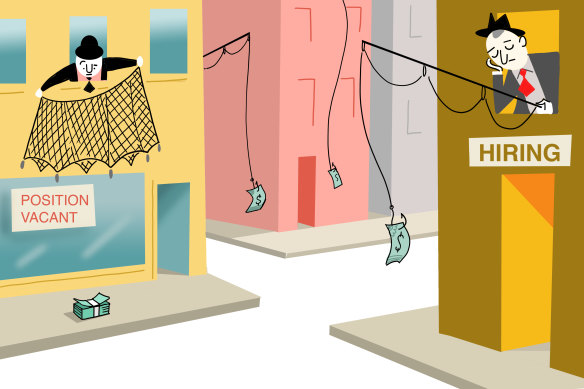
Last week, something strange happened without anyone noticing. We got the best monthly report on the jobs market we’ve ever had, and it was greeted with dismay. The message we’ve yet to get is that, when it comes to the need for jobs, our world has been turned on its head.
Every month, the Australian Bureau of Statistics gives us the latest figures for what’s happening to employment and unemployment, based on a huge sample survey of Australia’s 10.5 million households. The figures we got last week, for September, showed that the number of Australians with jobs increased by more than 64,000 during the month, to 14.5 million. The number of people unemployed – wanting a job, but unable to find one – fell by 9000 to a bit under 620,000.

Illustration: Simon LetchCredit:
Why was this the best jobs report we’ve had? Because the proportion of the working-age population with a job reached an all-time high of 64.4 per cent. During September, the number of full-time jobs grew by 51,000, to reach 10 million for the first time. So, more than 80 per cent of the extra jobs were full-time.
If the economy was booming, this strong growth in employment wouldn’t be so surprising. But the Reserve Bank has been applying the interest-rate brakes since May 2022, and the economy’s growth has been very weak for the past year or more. The only thing that’s been growing strongly is the population – which makes the limited worsening in unemployment all the more surprising.
The new Minister for Employment, Murray Watt, boasted that more than a million extra jobs had been created since the Albanese government came to office in May 2022. “This is the most jobs ever created in a single parliamentary term by any Australian government,” he said immodestly.
Loading
So why was last week’s good news greeted with dismay? Because it was taken to mean the Reserve Bank will be in no hurry to start cutting interest rates. You know the media: always look on the dark side of life.
Rates will come down in due course, of course. And with the jobs market holding up as well as it has, it gets ever harder to fear the economy will drop into recession. Silly people judge recession by whether the economy’s production of goods and services – gross domestic product – starts going backwards. But what makes recessions something to be feared is not what happens to production, but what happens to employers’ demand for workers. To the rate of unemployment, in other words. It’s when people can’t find work that they feel pain even greater than the pain people with big mortgages are feeling at present.
When the pandemic lockdowns ended and people were finally able to get out and spend the money they’d earned, businesses started hiring more workers and unemployment fell sharply. By the end of 2022, the rate of unemployment got down to 3.5 per cent – the lowest it had been in about 50 years.









 Add Category
Add Category